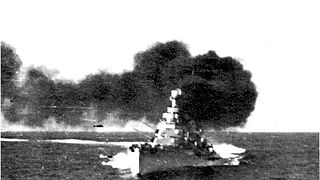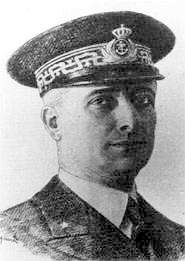Italian ship Vittorio Veneto may refer to:
- Italian battleship Vittorio Veneto - a Littorio-class battleship
- Italian cruiser Vittorio Veneto - a unique helicopter carrying cruiser
Italian ship Vittorio Veneto may refer to:

The Battle of Cape Matapan was a naval battle during the Second World War between the Allies, represented by the navies of the United Kingdom and Australia, and the Royal Italian navy, from 27 to 29 March 1941. Cape Matapan is on the south-western coast of the Peloponnesian Peninsula of Greece.
Roma was the name of three ships of the Regia Marina, and may refer to:

The Battle of Calabria, known to the Italian Navy as the Battle of Punta Stilo, was a naval battle during the Battle of the Mediterranean in the Second World War. Ships of the Italian Regia Marina were opposed by vessels of the British Royal Navy and Royal Australian Navy. The battle occurred 30 miles to the east of Punta Stilo, Calabria, on 9 July 1940. It was one of the few pitched battles of the Mediterranean campaign during the Second World War involving large numbers of ships on both sides. Both sides claimed victory, but in fact the battle was a draw and everyone returned to their bases safely.

The Battle of Cape Spartivento, known as the Battle of Cape Teulada in Italy, was a naval battle during the Battle of the Mediterranean in the Second World War, fought between naval forces of the Royal Navy and the Italian Regia Marina on 27 November 1940.

Vittorio Veneto was the second member of the Littorio-class battleship that served in the Italian Regia Marina during World War II. The ship's keel was laid down in October 1934, launched in July 1937, and readied for service with the Italian fleet by August 1940. She was named after the Italian victory at Vittorio Veneto during World War I, and she had three sister ships: Littorio, Roma, and Impero, though only Littorio and Roma were completed during the war. She was armed with a main battery of nine 381-millimeter (15.0 in) guns in three triple turrets, and could steam at a speed of 30 knots.

Littorio was the lead ship of her class of battleship; she served in the Italian Regia Marina during World War II. She was named after the Lictor, in ancient times the bearer of the Roman fasces, which was adopted as the symbol of Italian Fascism. Littorio and her sister Vittorio Veneto were built in response to the French battleships Dunkerque and Strasbourg. They were Italy's first modern battleships, and the first 35,000-ton capital ships of any nation to be laid down under the terms of the Washington Naval Treaty. Littorio was laid down in October 1934, launched in August 1937, and completed in May 1940.

The Littorio class, also known as the Vittorio Veneto class, was a class of battleship of the Regia Marina, the Italian navy. The class was composed of four ships—Littorio, Vittorio Veneto, Roma, and Impero—but only the first three ships of the class were completed. Built between 1934 and 1942, they were the most modern battleships used by Italy during World War II. They were developed in response to the French Dunkerque-class battleships, and were armed with 381-millimeter (15.0 in) guns and had a top speed of 30 knots. The class's design was considered by the Spanish Navy, but the outbreak of World War II interrupted construction plans.

Trieste was the second of two Trento-class heavy cruisers built for the Italian Regia Marina. The ship was laid down in June 1925, was launched in October 1926, and was commissioned in December 1928. Trieste was very lightly armored, with only a 70 mm (2.8 in) thick armored belt, though she possessed a high speed and heavy armament of eight 203 mm (8.0 in) guns. Though nominally built under the restrictions of the Washington Naval Treaty, the two cruisers significantly exceeded the displacement limits imposed by the treaty. The ship spent the 1930s conducting training cruises in the Mediterranean Sea, participating in naval reviews held for foreign dignitaries, and serving as the flagship of the Cruiser Division. She also helped transport Italian volunteer troops that had been sent to Spain to fight in the Spanish Civil War return to Italy in 1938.

Trento was the first of two Trento-class cruisers; they were the first heavy cruisers built for the Italian Regia Marina. The ship was laid down in February 1925, launched in October 1927, and was commissioned in April 1929. Trento was very lightly armored, with only a 70 mm (2.8 in) thick armored belt, though she possessed a high speed and heavy armament of eight 203 mm (8.0 in) guns. Though nominally built under the restrictions of the Washington Naval Treaty, the two cruisers significantly exceeded the displacement limits imposed by the treaty.

The First Battle of Sirte was fought between the British Royal Navy and the Regia Marina during the Mediterranean campaign of the Second World War. The engagement took place on 17 December 1941, south-east of Malta, in the Gulf of Sirte. It was tactically inconclusive as both forces were limited by the strategic goal of protecting a convoy of their own and as such, neither were looking to force a full scale engagement.

Vittorio Veneto was a helicopter cruiser that served with the Italian Navy. Originally intended to be a class of two ships specifically designed for anti-submarine warfare (ASW), only Vittorio Veneto entered into service in 1969, its sister ship Italia being cancelled. Vittorio Veneto was decommissioned in 2003. This ship has the same general layout as the smaller Andrea Doria-class helicopter cruisers, but with two elevators in the flight deck and the hangar below, rather than with the hangar as part of the superstructure. It was named for the decisive Battle of Vittorio Veneto which ended World War I on the Italian front.

Naval Battles is a turn-based, card-driven wargame based on naval combat during World War II. Designed by Dan Verssen and published by Phalanx Games, the game is playable by 2 or more players, each commanding a fleet with the objective of sinking a certain amount of their opponents' ships.

Carlo Bergamini was an Italian admiral.
Cantieri Riuniti dell'Adriatico was an Italian manufacturer in the sea and air industry which was active from 1930 to 1966. This shipyard is now owned by Fincantieri.

The aircraft cruiser is a warship that combines the features of the aircraft carrier and a surface warship such as a cruiser or battleship.
Veneto is a region of northern Italy.

Roma, named after two previous ships and the city of Rome, was the third Littorio-class battleship of Italy's Regia Marina. The construction of both Roma and her sister ship Impero was due to rising tensions around the world and the navy's fear that only two Littorios, even in company with older pre-First World War battleships, would not be enough to counter the British and French Mediterranean Fleets. As Roma was laid down almost four years after the first two ships of the class, some small improvements were made to the design, including additional freeboard added to the bow.
Vittorio Veneto may refer to:

Carlo Cattaneo was an Italian admiral during World War II. He was killed in the Battle of Cape Matapan.